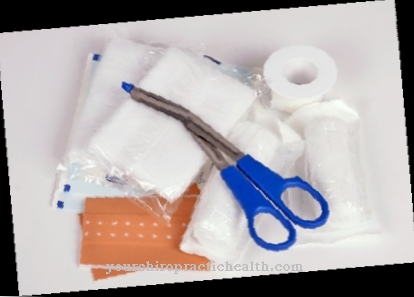At amalgam it is a mercury alloy that can occur in different variations. In dentistry, a variant of the amalgam has been used as a tooth filling for centuries thanks to its positive properties. Half of the medical amalgam consists of mercury, the other half consists of a mixture of copper, silver and tin.
Amalgam is medically controversial because of its mercury component. Although it is a very inexpensive material, subsequent health problems such as amalgam poisoning cannot be ruled out in principle.
What is amalgam?

From a chemical point of view, amalgam is an alloy of mercury. In addition to a number of naturally occurring amalgams, there are also a number of technical amalgams that are manufactured for various purposes.
Amalgam is particularly known for its use in dentistry. There it is often used as a filling material for damaged teeth. The dental amalgam consists of half of mercury and half of a metallic powder mixture of silver, copper and tin. Both are processed into a paste and can then be poured into the tooth, where it then hardens to form a resistant filling.
Shapes, types & types
Since there are many metals that are soluble in mercury, there are also many different amalgams. Depending on the amount of mercury, these amalgams are liquid to solid at room temperature. The higher the mercury content, the more liquid the corresponding amalgam, since mercury is liquid even at room temperature.
In addition to naturally occurring amalgams with lead, copper, palladium, silver or gold, there are also technical, artificially produced amalgams that are often used as reducing agents in chemistry or in low-temperature thermometers. Well-known technical amalgams are the aluminum amalgam, the sodium amalgam, the ammonium amalgam, the thallium amalgam and the gold amalgam. However, the well-known dental amalgam also belongs to the technical amalgams. This was the only type of amalgam that was often used as a filling material in dentistry.
Structure & functionality
Dental amalgam is used when a tooth affected by caries had to be drilled and the existing hole then re-filled. For an amalgam filling, the dentist must thoroughly mix the metals contained in the alloy, i.e. the mercury and a powder mixture of copper, silver and tin. The dentist then has about 10 to 30 minutes to bring the filling into the correct position. This also includes adapting the filling to the teeth. After this period of time, the filling begins to harden and can be polished so that the transitions between the filling and the tooth become smooth. After just 60 minutes, the finished filling can withstand light loads.
During the hardening process, the mercury combines with the silver, changing the state of the filling from malleable to solid. After about 24 hours, the amalgam filling is completely hardened and very resistant. If there are no medical problems, the finished filling can remain in the tooth for about 10 years if it is professionally and flawlessly made.
The body is exposed to mercury primarily before the amalgam filling has completely hardened. In the fully hardened state, mercury can no longer escape from the alloy, as the silver binds the mercury. However, despite the hardness of the material, abrasion of the filling cannot be completely prevented.
A professionally made amalgam filling is very easy to care for. General dental care is sufficient. A regular check at the dentist is still advisable. The transition between the filling and the tooth should be polished occasionally to avoid the risk of caries at the transition. In addition, the amalgam filling should be examined for its correct fit and any cracks, as in such a case it would have become leaky. Caries can then quickly form under a loosely fitting filling.
You can find your medication here
➔ Medicines against tartar and tooth discolorationMedical & health benefits
Amalgam finds its medical use as a tooth filling. Amalgam has been the most frequently used filling material for tooth decay for several centuries. This is due to its numerous positive properties: Dental amalgam is not only very inexpensive, but also robust and resistant to pressure and moisture, break-proof and very long-lasting.
In terms of expansion at different temperatures, amalgam and tooth enamel have very similar properties. Furthermore, an amalgam filling can be made quickly and easily and can remain in the tooth for up to ten years.
However, the uses for amalgam in dentistry are limited. In the case of complex fillings such as a root filling or a build-up filling under existing crowns, an alternative filling material is usually used.
Amalgam is also often criticized as a filler material because of its high mercury content. Although the exposure to the body is in the non-measurable range, the material was classified by the EU as “low risk” in 2014, which corresponds to a different judgment as “not dangerous”. In Sweden, Norway and Denmark, the use of amalgam has now been severely restricted. However, it is still a permitted, cost-effective alternative to other dental prostheses.
An alternative filling material should be used for people with a mercury allergy or kidney damage, as well as for pregnant and breastfeeding women. In addition to amalgam, plastics, glass mixtures, cement, ceramics or gold can also be used.




























